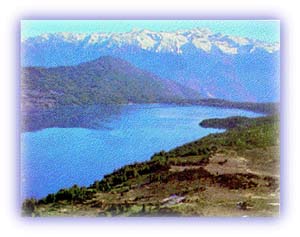Nepal Himalayas
General Info
· Solo Khumbu
· Namche Bazar
· Thyangboche
· Pangboche
· Kalapattar
· Pheriche
· Buddhism in Khumbu
· People: Sherpas
· Mount Everest
· The Quest for Everest
· Early Years
· The 1950s
· Sherpas on Everest
· Central Nepal
· Mustang
· Jomsom
· People: Thakalis
· Muktinath
· Manang valley
· Bryagu village
· Manang village
· Nyasang Division
· Western Nepal
· Jumla
· Sukhadik
Photo Feature:
· Annapurna region
High Altitude Sickness
Endangered Species
Protected Areas
· Royal Chitwan National Park
· Royal Bardiya National Park
· Mt. Everest National Park
Rara National Park
· Makalu-Barun National Park and Conservation Area
· Shey Phoksundo National Park
· Khaptad National Park
· Koshi Tapu Wildlife Reserve
· Parsa Wildlife Reserve
· Royal Sukla Phant Wildlife Reserve
· Dhorpatan Hunting Reserve
· Annapurna Area Conservation Project
Yaks
The Yeti Factor

![]()
|
Langtang National Park This is the park closest to Kathmandu, the capital city of Nepal. Located about 32 km (20 miles) north of Kathmandu, this park consists of the beautiful Langtang Valley, and several high altitude glacial lakes. One of the famous lakes is Gosainkunda, which is a sacred lake for Hindu pilgrims. People from the plains come every year to bathe in this icy cold lake in August. |
 |
| Red Panda Credit: Mahabir Pun |
The climatic pattern of the upper part of the park is similar to the climate of Mount Everest National Park. However, this park also includes some area with subtropical forest towards the south. Therefore a wider variety of vegetation and animals are found here.
Some of the wild animals found in this park are red pandas, musk deer, black bears, langur monkeys, ghorals, Himalayan thars and snow leopards.
This park also includes more than 40 villages which are totally dependent on the forest for wood and pastureland.
 |
| Rara Lake Credit: Mahabir Pun |
Rara National Park
From the east, the high pass of Bul-Bhulei (12,000 ft) forms
the gateway to the Rara National Park. Alpine meadows, when in
full bloom, present a beautiful picture. The green forests are
covered with coniferous deodar, fir, spruce and pine trees and,
at higher altitudes, with birch trees. This area falls in the
migratory paths of the Bhutias who travel between Mugo and
Jumla with their herds of goats, sheep, horses and cows.
The Rara National Park was founded in 1975 by H.M. Nepal Government for the conservation and protection of the beautiful forest environment. It has scope for being developed as a good tourist resort in the backward and under-developed part of Western Nepal. Rara is one of the four National Parks of Nepal, spread out over 44 square kilometers.
This park is named after a lake called Rara. This is one the biggest lakes in Nepal, covering an area of about 15 square kilometers at an elevation of 2,990 m ( 9,717 ft). The Rara Lake, formed on a plateau, is surrounded by beautiful forests of pine and fir. Exotic birds and rare wildlife can be seen in this protected area. The bow-shaped lake is surrounded by gently rolling mountains on all sides.
Originally, the Karnali River used to flow through this area. But due to some geological disturbance, the river passage got blocked and the lake must have been formed. This sweet-water lake is said to be 145 meters deep at the center and has a few streams flowing into it. It has only a very small outlet of water to the west. The National Park is administered by the park warden along with foresters, forest guards, and platoons of the Royal Nepalese Army. Park authorities zealously protect the flora and fauna and strict control is exercised to stop the grazing cattle menace.
The late King Mahendra, the predecessor of the present monarch, was very fond of this place and would camp for many days in the serene and awe-inspiring surroundings of the beautiful lake. He composed many beautiful poems while camping near this lake. On all sides, the lake is surrounded by gentle slopes covered with beautiful pine and fir forests, alpine flowers like potentillas, irises, geraniums, lilies of the valley, daisies, sweet peas, yellow dwarf chrysanthemums, phlox and nasturnums.
The lake is full of trout fish from 14 to 18" long. The trout fish are said to be slow and numbed by the cold water, and fishing is done in a novel way -- by means of spears.
The number of wild animals like deer, wild dogs, foxes, jackals, wild boars, bears, various types of jungle fowls, birds and vultures are said to be on the increase.
On the eastern side, there is a short takeoff and landing strip for small aircraft.
The Rara National Park was established to protect the unique beauty of the lake and to preserve the surrounding ecosystem. The lake is the home of water birds found in this area. This park has Himalayan bears, Himalayan thar, musk deer and snow leopards.
All rights reserved